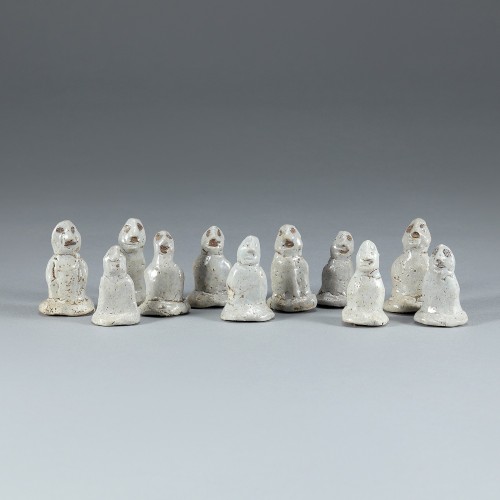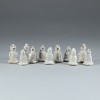본문
백자인형명기(白瓷人形明器)는 사후 세계의 안녕을 기원하며 함께 부장된 백자 인물상입니다.
순장 풍습이 사라지며, 그 자리를 대신해 상징적인 의미의 소형 명기가 부장되기 시작했습니다.
본 유물은 그중에서도 단순화된 형태와 소박한 조형이 특징이며, 정교한 묘사보다는 인물의 형상을 상징적으로 담아내는 데 중점을 두었습니다.
여러 점이 동시에 부장되었으며, 당대의 장례 문화 속에서 명기가 지닌 의례적 성격과 상징성을 잘 보여줍니다.
재질은 백자이며, 장식은 생략된 매끄러운 형태로 제작되었습니다.
━━━━━
此白瓷人形明器为陪葬于墓中的人物造型器物,寓意对死后世界安宁的祈愿。
随着殉葬风俗的废止,象征性的小型明器逐渐取而代之,成为丧葬礼制的重要组成部分。
本器物造型简练、朴素,着重以象征方式表现人物形象,未作细致刻画。
通常成组陪葬,体现出明器在当时丧葬文化中的礼仪性与象征意义。
通体以白瓷烧制,釉面光洁,无额外装饰。
━━━━━
The white porcelain human-shaped funerary figurine is a funerary object, symbolically accompanying the deceased with wishes for peace in the afterlife.
As the custom of live burial faded, small symbolic funerary objects came to replace actual human sacrifice in burial practices.
This particular artifact is characterized by its simplified form and modest modeling. Rather than aiming for detailed realism, it emphasizes a symbolic representation of the human figure.
Multiple such figurines were often buried together, and they clearly reflect the ritualistic and symbolic roles that myeonggi played within the funerary culture of the time.
Made of white porcelain, the piece is undecorated and has a smooth, unembellished surface.

